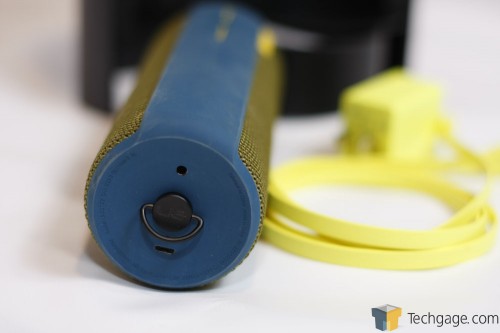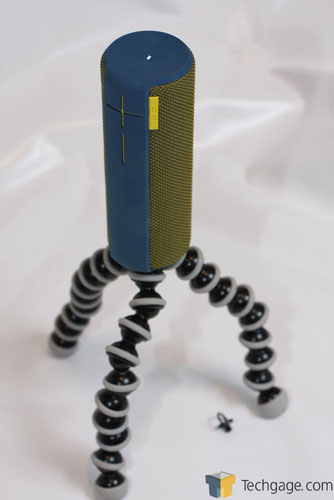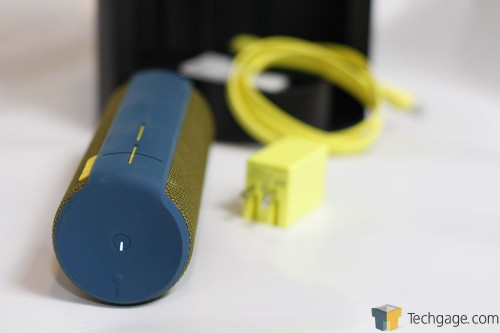- Qualcomm Launches Snapdragon 4 Gen 2 Mobile Platform
- AMD Launches Ryzen PRO 7000 Series Mobile & Desktop Platform
- Intel Launches Sleek Single-Slot Arc Pro A60 Workstation Graphics Card
- NVIDIA Announces Latest Ada Lovelace Additions: GeForce RTX 4060 Ti & RTX 4060
- Maxon Redshift With AMD Radeon GPU Rendering Support Now Available
Logitech UE BOOM Portable Speaker Review
The UE Boom from Logitech boasts an impressively hip advertising campaign and a promise to make music more “social” again. But past all of the buzzwords and pretty packaging, is this cylindrical speaker worth all of the hype? We take a close look… and can’t help but be blown away.
Page 1 – Introduction, Sound Quality & Battery Life
I’ll be the first to tell you that I’m not a true audiophile… which might make you wonder about why I’m the one that jumped at the opportunity to review Logitech’s latest consumer electronics gem, the UE Boom (I’m sorry, Logitech, I’m not typing BOOM in all caps – it’s annoying and I know way too much marketing to buy into it). UE stands for Ultimate Ears, a subsidiary brand of Logitech (since 2008)… but, for those uninitiated, don’t let that scare you off – think more Logitech Harmony and less Logitech $20 keyboard. We’re talking a brand name with some serious pedigree in wireless in-ear monitors for professional musicians since 1995, not some off-the-cuff noisemaker.
That being said, this is a $200 (sorry, $199.95 – more marketing fun!) wireless speaker that contains such buzzwords as “social” and “life resistant.” Seriously, I couldn’t make this up if I tried. And thus, my interest was piqued – a brand for professional musicians, making a product so clearly aimed towards “social” youth… can it be pulled off with finesse, or is it just an overpriced cash-out of a premier branding? I may not be a true audiophile, but I know my way around music well enough to hear a botched job. And when your branding is this much heavier than any of your published technical specs, I start to wonder what kind of lead is being sold as gold.

All gimmick aside, I’m going to put this right in the introduction so that you bother to get to the conclusion: If you push all the Marketing 201 drivel to the side (you may need heavy equipment for that), you’re left with a speaker that is worth its price, and worth tolerating the schlock for. As much as I will (mercilessly) mock the advertising and pitch, I come up short with reasons why not to buy this speaker if you need a portable one. And if you don’t need one, you have exactly one more reason than those who do… but whatever you currently have, this will kick your little tin can’s ass.
A Brief Description
So, what on earth does a wireless speaker that costs $200 USD look like? Well, it looks like… a cylinder, about 7.25″ tall and 3″ in diameter. It comes in colors (seriously, did you expect something with “social” in the tag-line to not include colors?!) – I got the blue and yellow, because (as Rob so kindly pointed out) I could use a little color in my life as an accountant. Personally, I like the look – and I love the weight. The Boom is not heavy at all (538 grams, or 1.18 lbs) and is clearly made to be portable.
The Boom comes with a D-ring screwed on (it uses a standard camera tripod screw, if anyone is wondering… I know I was) that allows it to be easily tied from a belt, hung from a bike handlebar or pretty much anything else you could want. This little addition goes a long way – you can put it wherever you want to get it in the way, out of the way or in the acoustically most sensible location. Here, you can see it screwed into my GorillaPod camera tripod – which allows me to put it pretty much anywhere.
The outside is rubberized, including the end caps and a strip going completely down the length of the device that covers a roughly 45 degree arc and contains the large, easily accessible volume buttons. The rest of the Boom, at least from the sides, is speaker grille. The power and connection buttons are seamlessly under the rubber on one end while the micro-USB charging port, D-ring and auxiliary 3.5mm input jack are on the other side.
Theoretically (according to the speaker’s app), there should also be a cover that goes under the D-ring to plug and waterproof these ports – however, my unit shipped without one, so I cannot confirm or deny this. (Note: Logitech’s contacted us to let us know that the UE BOOM does in fact include port covers.)
Setup and Usage
I’m not sure if I’m that segment of the market Logitech was most aiming towards, but I am in at least a part of its market – I think things like this should Just F-ing Work(tm), and they should be able to do it in the environments I am most likely to use them. That means a portable speaker should connect easily, have good battery and be able to survive a bit of life outdoors. After all, if I were inside in my house, I’d have a proper stereo system to connect to!
Setting up the UE Boom was nothing short of marvelously exceeding my expectations. I turned it on, went to “Bluetooth” on my iPhone, and clicked on the “UE Boom.” That’s it. From there, it just worked. It connected when I was within range (about 25 feet, which is impressive for Bluetooth), it gave me a nice little icon at the top of my phone outlining its battery power, and it played whatever it was told to. Associating it to new devices required nothing more than holding down the “Bluetooth” button near the power button for three seconds, and repeating that procedure. Since the Boom recognizes the last eight devices, new pairings never kicked me out of being able to re-sync my own devices later without having to re-do the discovery procedure… even after my wife, brother and friend each took a turn playing DJ.
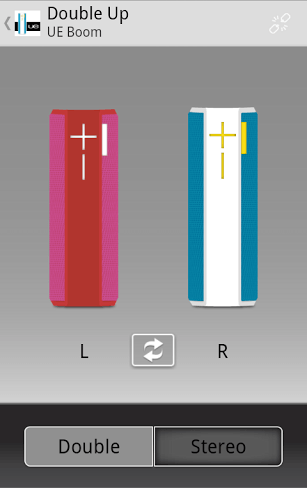
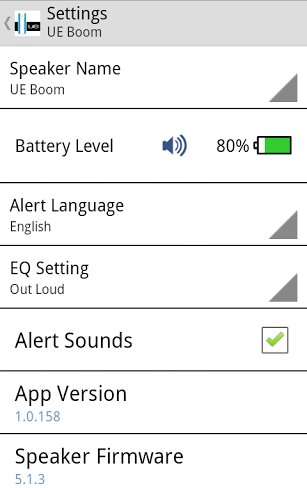
Battery life and connection settings (found connection, lost connection) are each given their own set of audio clues that play through the speaker, as well. This allows you no-guesswork feedback for whether you’re ready to play your music or not. Though it may seem a little silly, it’s a really nice feature when it signals that your device has gone out of range (lost signal), or gives you a warning that battery level is at critical when it either shuts down or won’t fire back up. These little things are a welcome reprieve from just having to diagnose blinking lights, and in a party atmosphere it’s wonderful to get a clearly-stated audible warning, rather than taking a guess as to what that lone red LED means. These are dumb little features that most people don’t know are missing until they use a device that has them – imagine your keyboard or remote telling you “Critical battery, please recharge or replace” instead of just not typing, or not turning on your TV.
Further tweaking of the Boom outside of power, volume and basic connection can be done through its associated app (on both Apple and Android devices), including adjusting the equalizer or even pairing a second Boom to have each play a separate channel of the music. This is a really, really nice feature… even though I find it unlikely that you will have two people each walking into the same room with their own personal $200 speaker, so I wouldn’t bet the bank on this one being used a lot. Should you choose to just double the volume instead of split the output, you can use that other Boom as a second full-stereo speaker. Since we only got one unit for testing (I hadn’t thought to request one more to try these features out), I will have to take it on Logitech’s good word that it works. If I get the opportunity to try it in the near future, I will happily update this review further to discuss lag, difficulties or just glowing praise for this ability. Until then, know that the marketing materials say you can do it – and that issues may or may not apply. The marketing materials also use words like “riot” and “life resistant”, so… caveat emptor until we test it.
Sound Quality and Battery Life
Ok, so I’m not an audiophile… I disclosed that part freely at the start of my review – so if you want a complete breakdown of sound quality, you’ll have to look elsewhere. That being said, most people who would need this device are probably not true audiophiles either – most of us don’t keep our music in FLAC or even buy separate soundcards for our PCs anymore (seriously, I’m fine with Intel Azalea audio… bring on your pitchforks and torches!). However, that simply means we may not be able to discern GREAT sound from REALLY GOOD sound… it doesn’t mean we don’t know GOOD from BLOODY TERRIBLE.
The UE Boom was able to keep up with my audio collection well enough that I could hear the difference between my 192KB MP3s and those of lesser quality, throughout the entirety of its volume range that was within my comfortable listening threshold. Translation for non-geeks: The sound quality is clear as a bell for as loud as this thing will go, and that volume is uncomfortably loud to me at 10 feet away. This is where the UE pedigree really pays off – a company that’s designed in-ear acoustics (which don’t get a lot of power to work with) trying to overcome an entire stage amplification setup knows a thing or two about getting a lot out of a little… and wow, does it deliver on this one.
It doesn’t take all THAT much skill to make good sound, and it takes even less to make loud sound. However, anyone who has ever played a musical instrument knows that there is an exponential curve therein – it takes a LOT of skill to make good, loud sound. The louder it gets, the better your skill has to be (or, at the very least, the bigger your equipment) to prevent distortion. At full volume and 10 feet, I was still able to play “name that bit rate” from my collection.
As for the battery life, well… that was a bit of a different story. The UE Boom boasts 15 hours in its marketing materials (depending on volume, of course). I’m not sure what the bloody hell they used to eke out 15 hours, but I got a lot closer to between four and six in real-world usage depending on both bluetooth distance and volume. Granted, I didn’t have the thing on nearly mute – but most people wouldn’t. Of course, six hours of wireless music at high volume is pretty impressive – and more than enough to keep a party going. If you find that you want more, surely you can find a single power outlet within that timespan… the tunes will keep cranking while the device is plugged in.
For what it’s worth, I envision that most people would use the device like I do… crank the speaker volume up, and then control its playback volume through use of your phone’s volume. Every audiophile just cried a little bit… I know that I *should* put my phone up to maximum (where the signal is entirely digital) and then use the speaker to control the volume, so that the speaker can comfortably work within its optimal analog settings. Sue me, I’m lazy… and I have a feeling anyone hosting a party would be equally lazy. This gets further complicated with pairing multiple devices (as outlined later) or when your music library’s volumes are all over the charts (as in the case of my own). These things just make all the more reason to control the volume from your phone instead of the speaker – and all the more reason that 15 hours is just not a realistic figure.
As a side note, currently, the Boom application for your mobile device will not be able to tell you either the current volume level as a percentage of max, or allow you to change said level. Currently, the only control to that is on the speaker itself, which should be considered the “max” volume and then adjusted from your device. My recommendation is to play the quietest song on your playlist at the loudest you want it to be, and use that as your baseline – all other music can be reduced from your phone’s volume. This is an odd oversight in an otherwise flawless execution. At $200 for a single speaker, I would think volume should be accessible from my handset at a bare minimum – I’d actually expect more along the lines of a setting for automatic normalization of volume based on prior tracks! For the target market, this is vital – quieter songs should be able to play alongside the loud and heavy without disappearing.
Support our efforts! With ad revenue at an all-time low for written websites, we're relying more than ever on reader support to help us continue putting so much effort into this type of content. You can support us by becoming a Patron, or by using our Amazon shopping affiliate links listed through our articles. Thanks for your support!




